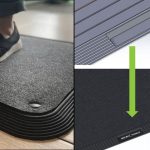Introduction
Definition of rubber speed bumps
Rubber speed bumps are traffic control devices that are made from durable rubber material. They are designed to slow down vehicles and improve safety on the roads. These road bumps are commonly used in residential areas, parking lots, and other areas where speed control is necessary. The rubber material used in their construction is flexible and can withstand various weather conditions, making them suitable for both indoor and outdoor use. Additionally, rubber speed bumps are easy to install and can be removed or repositioned as needed. Overall, these traffic control devices provide an effective and cost-efficient solution for managing vehicle speed and ensuring the safety of pedestrians and drivers alike.
Importance of traffic control
Traffic control plays a crucial role in ensuring the safety and efficiency of our roadways. It helps to regulate the flow of vehicles, prevent accidents, and minimize congestion. One important aspect of traffic control is the use of rubber speed bumps. These speed bumps provide an effective way to slow down vehicles in areas where speed limits need to be enforced, such as residential neighborhoods, school zones, and parking lots. The benefits of using rubber speed bumps are numerous. They are highly visible, durable, and can withstand heavy traffic. Additionally, they are designed to reduce vehicle speed without causing damage to vehicles. By incorporating rubber speed bumps into traffic control measures, we can create safer and more organized roadways for everyone.
Advantages of Rubber Speed Bumps
Improved safety
Rubber speed bumps offer a multitude of benefits when it comes to improving safety on the roads. Firstly, these speed bumps are highly visible due to their bright colors, making them easily noticeable for drivers. This increased visibility helps to alert drivers to slow down and proceed with caution, reducing the risk of accidents. Additionally, rubber speed bumps are designed to provide a gentle and controlled deceleration for vehicles, minimizing the potential for abrupt stops or jolts. This ensures a smoother driving experience and reduces the likelihood of sudden collisions or damage to vehicles. Furthermore, the flexible nature of rubber speed bumps allows them to effectively absorb impact, thereby reducing the risk of injuries to pedestrians and cyclists. Overall, the use of rubber speed bumps as a traffic control measure greatly enhances safety on the roads and promotes a safer environment for all road users.
Reduced vehicle speed
Rubber speed bumps are an effective solution for reducing vehicle speed. These traffic control devices are designed to slow down vehicles and promote safer driving habits. By strategically placing rubber speed bumps in areas where speed needs to be controlled, such as residential neighborhoods or school zones, drivers are compelled to slow down and adhere to the speed limit. This helps to prevent accidents and protect pedestrians, cyclists, and other road users. Additionally, rubber speed bumps are preferred over traditional concrete or asphalt speed bumps due to their ability to provide a smoother and more comfortable ride for vehicles. Their flexibility and shock-absorbing properties minimize the impact on vehicles, reducing wear and tear on tires and suspensions. Overall, the use of rubber speed bumps is a cost-effective and efficient way to ensure reduced vehicle speed and enhance traffic safety.
Cost-effective solution
Rubber speed bumps offer a cost-effective solution for traffic control. Unlike traditional concrete speed bumps, rubber speed bumps are more affordable to install and maintain. They are made from durable materials that can withstand heavy traffic and harsh weather conditions, reducing the need for frequent repairs or replacements. Additionally, rubber speed bumps are easy to install and can be easily relocated if needed. This flexibility makes them a cost-effective choice for both temporary and permanent traffic control measures. Overall, using rubber speed bumps can help save costs while effectively managing traffic flow and ensuring road safety.
Environmental Benefits
Made from recycled materials
Rubber speed bumps are an excellent choice for traffic control due to their sustainability factor. Made from recycled materials, these speed bumps help reduce waste and minimize the environmental impact. By utilizing rubber from old tires or other rubber products, these speed bumps provide a second life to materials that would otherwise end up in landfills. This not only helps conserve natural resources but also reduces the carbon footprint associated with manufacturing new materials. Furthermore, the use of recycled rubber speed bumps promotes a circular economy by encouraging the reuse of materials in a continuous cycle. Overall, opting for rubber speed bumps made from recycled materials is a smart and environmentally-friendly choice for effective traffic control.
Reduced carbon footprint
Rubber speed bumps offer numerous benefits when it comes to reducing carbon footprint. Unlike traditional concrete speed bumps, rubber speed bumps are made from recycled materials, such as old tires, which helps to minimize waste and promote sustainability. Additionally, the production process of rubber speed bumps requires less energy and generates fewer greenhouse gas emissions compared to concrete speed bumps. By choosing rubber speed bumps for traffic control, communities can contribute to the reduction of carbon footprint and make a positive impact on the environment.
Minimal impact on the environment
Rubber speed bumps offer numerous benefits when it comes to traffic control, and one of the most significant advantages is their minimal impact on the environment. Unlike traditional concrete speed bumps, which require extensive resources and energy to manufacture, rubber speed bumps are made from recycled materials. This not only reduces the amount of waste going to landfills but also decreases the carbon footprint associated with their production. Additionally, rubber speed bumps are designed to be durable and long-lasting, reducing the need for frequent replacements. This further minimizes the environmental impact by reducing the consumption of raw materials. By choosing rubber speed bumps for traffic control, communities can contribute to a more sustainable and eco-friendly approach to managing traffic flow.
Versatility and Customization
Suitable for various road types
Rubber speed bumps are highly suitable for various road types. Whether it is a busy city street, a residential neighborhood, or a commercial parking lot, rubber speed bumps can effectively control traffic and ensure the safety of pedestrians and drivers. These speed bumps are designed to withstand heavy traffic flow and adverse weather conditions, making them ideal for both urban and rural areas. Additionally, rubber speed bumps are easy to install and maintain, reducing the overall cost and inconvenience associated with traditional concrete or asphalt speed bumps. With their versatility and durability, rubber speed bumps are an excellent choice for traffic control on different types of roads.
Different sizes and colors available
Rubber speed bumps for traffic control offer a wide range of options in terms of sizes and colors. Whether you need a small speed bump for a residential area or a larger one for a busy road, there are different sizes available to suit your specific needs. Additionally, rubber speed bumps come in various colors, allowing you to choose the one that best matches your surroundings or enhances visibility. This flexibility in size and color ensures that you can effectively control traffic while maintaining the aesthetic appeal of the area.
Can be customized with reflective markings
Rubber speed bumps for traffic control can be customized with reflective markings, which enhance their visibility during low-light conditions. The addition of reflective markings allows drivers to easily identify the presence of speed bumps, ensuring that they slow down and navigate safely. This customization option is particularly beneficial in areas with limited street lighting or high traffic volume, where visibility is crucial for effective traffic control. By incorporating reflective markings, rubber speed bumps not only provide a physical barrier to regulate speed but also serve as a visual warning to drivers, promoting overall road safety.
Conclusion
Summary of benefits
Rubber speed bumps offer numerous benefits for traffic control. Firstly, they are highly effective in reducing vehicle speed, ensuring safer roads for both drivers and pedestrians. Additionally, rubber speed bumps are durable and can withstand heavy traffic, making them a long-lasting solution for traffic management. Moreover, these speed bumps are easy to install and can be customized to fit different road conditions. They also provide a cost-effective option compared to other traffic control measures. Overall, the use of rubber speed bumps is a practical and efficient way to enhance traffic safety and control.
Rubber speed bumps offer several key benefits that make them an ideal choice for traffic control. One of the main advantages is their ability to provide a gentle and smooth ride for vehicles, minimizing any discomfort or damage. This is particularly beneficial for emergency vehicles and public transportation, as it allows them to maintain a steady speed without compromising passenger safety. Additionally, rubber speed bumps are highly durable and long-lasting, capable of withstanding heavy traffic flow and extreme weather conditions. They are also easy to install and maintain, reducing both time and costs. Furthermore, rubber speed bumps are environmentally friendly, as they are made from recycled materials and are fully recyclable themselves. By using rubber speed bumps, communities can contribute to sustainable practices while ensuring efficient traffic control and enhancing road safety.







